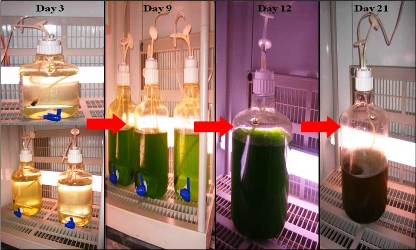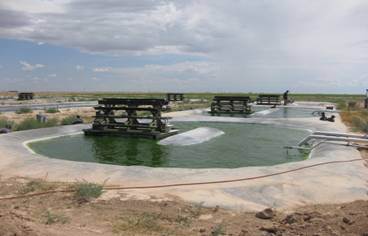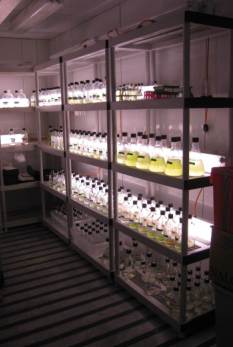Biofuels
 Arguably, the single most important issue facing the 21st century is the impeding energy crisis. Continued use of petroleum sourced fuels is widely recognized as unsustainable because of depleting supplies and the contribution of these fuels to the accumulation of CO2 in the environment. Renewable, C neutral, transport fuels are needed for environmental and economic sustainability. Biodiesel derived from oil crops (e.g., corn, soy beans, sunflowers) is a potential renewable and carbon neutral alternative to petroleum fuels but none of these oil crops will satisfy even a small fraction of the existing demand for transport fuels. Microalgae appear to best suited to meeting the global demand for transport fuels given they can produce 3500 gallons (with some estimates as high as 15,000 gallons) of oil annually per acre.
Arguably, the single most important issue facing the 21st century is the impeding energy crisis. Continued use of petroleum sourced fuels is widely recognized as unsustainable because of depleting supplies and the contribution of these fuels to the accumulation of CO2 in the environment. Renewable, C neutral, transport fuels are needed for environmental and economic sustainability. Biodiesel derived from oil crops (e.g., corn, soy beans, sunflowers) is a potential renewable and carbon neutral alternative to petroleum fuels but none of these oil crops will satisfy even a small fraction of the existing demand for transport fuels. Microalgae appear to best suited to meeting the global demand for transport fuels given they can produce 3500 gallons (with some estimates as high as 15,000 gallons) of oil annually per acre.
 Microalgae convert CO2 to biofuels, foods, feeds and high-value bioactives on a small foot print, are more cost efficient (fertilizer, shipping) and environmental friendly (uses waste water, CO2 from power plants). Many species are rich in oil (20–50% of dry biomass) and grow rapidly (double their biomass within 24 h). An estimated <10% of the total U.S. cropping area would be sufficient for producing algal biomass to satisfy current transport fuel needs. While the idea of using microalgae as a source of fuel is not new, it is now being taken seriously because of the escalating price of petroleum (>$100 barrel) and, more significantly, the emerging concern about global warming that is associated with burning fossil fuels.
Microalgae convert CO2 to biofuels, foods, feeds and high-value bioactives on a small foot print, are more cost efficient (fertilizer, shipping) and environmental friendly (uses waste water, CO2 from power plants). Many species are rich in oil (20–50% of dry biomass) and grow rapidly (double their biomass within 24 h). An estimated <10% of the total U.S. cropping area would be sufficient for producing algal biomass to satisfy current transport fuel needs. While the idea of using microalgae as a source of fuel is not new, it is now being taken seriously because of the escalating price of petroleum (>$100 barrel) and, more significantly, the emerging concern about global warming that is associated with burning fossil fuels.
The goal of the work at TAMUG is to identify microalgae and growth conditions that provide for the biosynthesis of long chain hydrocarbons with the greatest biofuel potential. This work is being conducted in conjunction with faculty, staff and students at the various Texas Agrilife Research facilities across this state: College Station, Pecos, Lubbock, Corpus Christi. Numerous teams are working to a common goal by addressing this issue including, but not limited to, those focused on large scale processes, harvesting, digestion and economical assessments.
Recent Publications
 Nunez, M. and Quigg, A. 2016 Changes in growth and composition of the marine microalgae Phaeodactylum tricornutum and Nannochloropsis salina in response to changing sodium bicarbonate concentrations. Journal Applied Phycology. 28: 2123-2138. doi: 10.1007/s10811-015-0746-7.
Nunez, M. and Quigg, A. 2016 Changes in growth and composition of the marine microalgae Phaeodactylum tricornutum and Nannochloropsis salina in response to changing sodium bicarbonate concentrations. Journal Applied Phycology. 28: 2123-2138. doi: 10.1007/s10811-015-0746-7.
Jiang, Y., Nunez, M., Laverty, K.S., and Quigg, A. 2015 Coupled effect of silicate and nickel on the growth and lipid production. Journal of Applied Phycology. 27: 1137-1148. doi: 10.1007/s10811-014-0412-5
Jiang, Y., Laverty, K.S., Brown, J., Brown, L., Chagoya, J., Burow, M. and Quigg, A. 2015 Effect of silicate limitation on growth, cell composition and lipid production of three native diatoms to Southwest Texas desert. Journal of Applied Phycology. 27: 1433-1442. doi: 10.1007/s10811-014-0463-7
Chagoya, J.C., Brown, J., Gomez, S.M., Zhang, J., Jiang, Y., Laverty, K., Brown, L., Quigg, A. and Burow, M. D. 2014 Media Optimization and Lipid Formation of Two Native Diatoms for Cultivation in the Southwest Texas Desert. Journal of Applied Phycology. DOI 10.1007/s10811-014-0238-1
Jiang, Y., Laverty, K.S., Brown, J., Nunez, M., Brown, L., Chagoya, J., Burow, M. and Quigg, A. 2014 Effects of fluctuating temperature and silicate supply on the growth, biochemical composition and lipid accumulation of Nitzschia sp. Bioresource Technology 154: 336–344.
Jiang, Y., Yoshida, T.*, and Quigg, A. 2012. Photosynthetic performance, lipid production and biomass composition in response to nitrogen limitation in marine microalgae. Plant Physiology and Biochemistry. 54: 70-77. *NSF REU student
Nunez, M. and Quigg, A. 2016 Changes in growth and composition of the marine microalgae Phaeodactylum tricornutum and Nannochloropsis salina in response to changing sodium bicarbonate concentrations. Journal Applied Phycology. DOI: 10.1007/s10811-015-0746-7.
Jiang, Y., Nunez, M., Laverty, K.S., and Quigg, A. 2015 Coupled effect of silicate and nickel on the growth and lipid production. Journal of Applied Phycology. 27: 1137-1148. DOI:10.1007/s10811-014-0412-5
Jiang, Y., Laverty, K.S., Brown, J., Brown, L., Chagoya, J., Burow, M. and Quigg, A. 2015 Effect of silicate limitation on growth, cell composition and lipid production of three native diatoms to Southwest Texas desert. Journal of Applied Phycology. 27: 1433-1442. DOI: 10.1007/s10811-014-0463-7